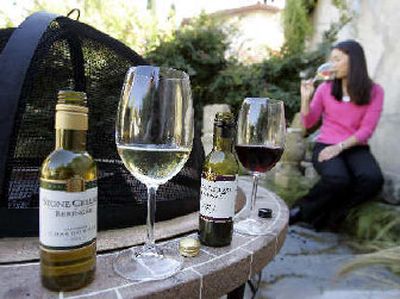Vintners say less is more in search for better bottle

YOUNTVILLE, Calif. — The next big thing for the wine industry could be small, screw-capped and shatterproof.
Single-serve plastic bottles are starting to show up on supermarket shelves in a bid to win over new customers by moving wine beyond posh white-tablecloth dinners to the informal ease of a picnic.
If one of these green bottles should accidentally fall, no problem.
“There’s a more active lifestyle people are living, they’d like wine to be a part of it and it just was not convenient in the 750 milliliter typical wine glass bottle where you have to bring corkscrews, glasses, etc.,” says Tom Slone, brand manager for Stone Cellars by Beringer, which has been selling four-packs of unbreakable, single-serve bottles since this summer.
The new, 187 milliliter (about six fluid ounces) bottles are part of a larger trend in the industry that includes boxed wine, cans and carton-type packages.
“People, I think, are now into casual enjoyment of fine products,” says Wilfred Wong, cellar master for Beverages & More, who sees the move toward unconventional containers starting with the success of premium boxed products such as Black Box Wines.
There isn’t much sales data available yet on the plastic bottles, but the category in general, which includes glass bottles already being offered on planes and in delis and supermarkets, has been doing well. Sales of wine in 187 milliliter containers — mostly glass — totaled nearly $68 million for the 52 weeks ending Oct. 22, up about 22 percent from the year before, according to supermarket, drug and liquor store sales data from ACNielsen.
Overall, domestic wine sales were up about 9 percent to $3.9 billion, good news for the industry which has battled a grape glut in recent years.
The Stone Cellars mini bottles are made of a durable plastic designed to be tasteless and odorless. They look like regular bottles in miniature, right down to the little indentation on the bottom known as a “punt,” and are filled with the same fruit-forward, award-winning varietals — chardonnay, pinot grigio, merlot and cabernet sauvignon — that Stone Cellars puts in its full-sized glass bottles. Four-packs cost about $8.
“The consumer research that we did indicated that even though people were looking at a smaller size, they wanted a package that looked sophisticated,” says Slone. “We didn’t do anything trendy or quirky.”
That won over people like David Joachim, grill master for the American Tailgaters Association, who likes not having to worry about broken glass but isn’t ready to give up tradition entirely.
“The wine bottle itself is so iconic that when you put wine in something else it ruins the experience for some reason,” he says.
Another entrant in the unbreakable bottles market is Louisville, Ky.-based Brown-Forman Corp., which is selling Fetzer Vineyards Valley Oaks merlot, chardonnay and white zinfandel in the mini bottles as well as Virgin Vines, a joint venture with British tycoon Richard Branson.
The Virgin Vines singles will also be served on Branson’s Virgin Atlantic Airways, where the much-lighter plastic bottles carry a freight bonus.
Robert Smiley, a University of California, Davis, professor, who follows the wine industry sees the general lightening up as an interesting direction for a business that “has a lot to learn from the beer industry in terms of convenience.”
But can small, plastic bottles that open with a twist coexist with the glass act of $100-plus vintage wines?
No reason why not, says Smiley.
“You’ve got different people and they’ve got different preferences,” he says. “Convenience vs. tradition and high expectations vs. opening up a 187 milliliter when you’re out on a picnic.”